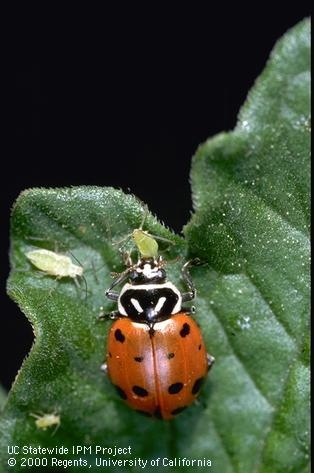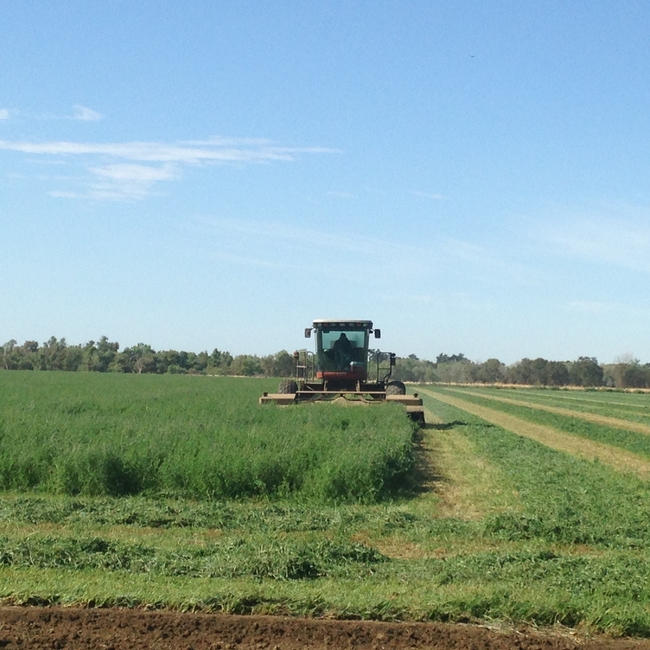By Daniel H Putnam
It's not clear that alfalfa growers fully knew that one of the most widely-used insecticides in their crop was about to be completely eliminated from use nationwide.
But it was - nearly. NOT an April Fools Day joke!
A complete withdraw of ‘tolerances' (legal uses) for chlorpyrifos (Lorsban, Lock-on) was scheduled for 31 March, 2017 but on 29th March, the US Environmental Protection Agency (EPA) made a decision that it would not proceed forward at this time with a revocation of all uses for this pesticide. Links to the EPA decision press release can be found here and the EPA order here.
Chlorpyrifos is one of the most widely used active ingredients (a.i.) in alfalfa in California, in other important CA crops (e.g. almonds, citrus, cotton), is used on over 200 crops nationwide and widely used overseas. California, with its high almond, alfalfa, citrus and specialty crop acreage would have been especially affected.
In the opinion of many entomologists and pest control advisors it is also an important tool in an Integrated Pest Management (IPM) program as a tool not only to control important pests, but to prevent damage to beneficial insects and to prevent pest resistance to insecticides (see report on chlorpyrifos published in 2014)

Lady-bird beetles (lady bugs) feeding on aphids in alfalfa. Protection of beneficial insects are an important aspect of an IPM strategy.
History. On October 30, 2015, the US-EPA proposed to revoke all us food tolerances for chlorpyrifos as a result of an earlier 9th US Circuit Court of Appeals decision. This was in response to a lawsuit and allegations by Natural Resources Defense Council (NRDC) and Pesticide Action Network North America (PANNA) about human health and safety concerns. In November of 2016, the EPA published its data, and allowed members of the public to comment, which led to the decision in March 2017.
The decision by the EPA this week was widely watched by California farmers and alfalfa producers in particular, many of whom breathed a sigh of relief since chlorpyrifos is very widely used. Chlorpyrifos (Lorsban, Lock-on) is a broad-spectrum insecticide effective on several major pests, particularly aphids and alfalfa weevils, and a significant component of an overall Integrated Pest Management (IPM) approach using diverse mode-of-action products.
This decision includes a promise to update its human health assessments (to be completed by October 2022), which will further guide the future of this pesticide. Human health concerns have caused some restrictions on chlorpyrifos use near residences and schools to be imposed in California separate from the EPA process (see label for any guidance for use of a pesticide).
California Usage in Alfalfa. Although other states don't collect detailed pesticide use data, chlorpyrifos use in alfalfa is likely greater here than other states due to its large acreage and long-season (opportunity for pests). The use has ranged between 125,000 and 200,000 acres per year (out of 750,000 to 1.1 million acres total acres) over the past 10 years, with about 79% of applications made by air. Peak usage is Feb-April and July-August during periods when the prominent pests are seen: weevils and aphids in the spring, and aphids and alfalfa caterpillar and armyworms in the summer.
UC Alfalfa Scientists and Growers Engaged. University of California scientists, growers, and Pest Control Advisors (PCAs) represented by the California Alfalfa & Forage Association have been important in addressing the issues associated with chlorpyrifos. Work on mitigating off-site movement of chlorpyrifos was conducted in the early 2000s, and a project conducted over the past 3 years resulted in a recommendation to state and federal regulators not to remove chlorpyrifos from use until suitable alternatives could be found. To summarize:
“Through a facilitated process, the Alfalfa Crop Team identified 10 insect pests for which chlorpyrifos was important and which required growers' continued access to it.”
Although recognizing the issues associated with environmental and human impacts, the group pointed to its critical use for aphid, weevil, and summer worm infestations and to the documented resistance to the pyrethroid class of insecticides (the most widely-used alternative insecticide in alfalfa). The group also documented the negative impacts of excessive use of pyrethroids on beneficial insects if that were the only class remaining, as reasons for keeping chlorpyrifos in the ‘tool box'.
For a full version of that chlorpyrifos report see "Identifying and Managing Critical Uses of Chlorpyrifos Against Key Pests of Alfalfa, Almonds, Citrus, and Cotton"
Although many factors likely led to this decision, the homework done by the Chlorpyrifos working group (consisting of representatives and experts in alfalfa, citrus, cotton, and almond) was important at informing state and federal regulators about the uses and options for chlorpyrifos in those important crops.
Importance of Good Stewardship. If nothing else, this ‘close call' should remind alfalfa growers of the importance of both engagement and good stewardship when managing pesticides.
Chlorpyrifos is important but just one of several tools our IPM tool box. PCAs and growers must commit themselves to be the best stewards of our resources, including insecticides. We must continue to demonstrate to the public that we are using all available methods for controlling pests including conservation of natural enemies, protection of pollinators, cultural practices (use of pest resistant varieties and adjusting harvest dates to mitigate pests) and diverse and appropriate insecticide options to prevent insect resistance.

Harvesting alfalfa, Yolo County, California. Harvest timing can be used as a pest management method using an IPM approach. California alfalfa is harvested up to 12 times per year.
Decision Tool. As a result of the Chlorpyrifos Project, UC ANR through the Statewide IPM program developed a Decision Support Tool plan the best approach to manage key insects in alfalfa and other crops for which chlorpyrifos is one choice. It summarizes the best management practices across the suite of insect pests selected. The Decision Support Tool is found here. The UC IPM website has a tremendous depth of information on pests and Integrated Pest Management in many crops.
Source:ucanr.edu